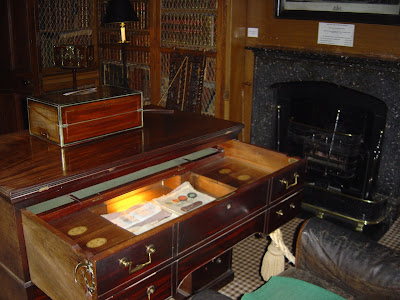The elaborate sanctuary of Sir Walter Scott
“It may be pertinacity, but to my eye, these grey hills, and all this wild border country, have beauties peculiar to themselves. I like the very nakedness of the land; it has something bold, and stern, and solitary about it. When I have been for some time in the rich scenery about Edinburgh, which is like ornamented garden land, I begin to wish myself back again among my own honest grey hills; and if I did not see the heather at least once a year, I think I should die!”
-Sir Walter Scott, as recorded by Washington Irving in 1817 (A Ramble with Sir Walter Scott).
They pause because this is where Scott had always allowed them to stop and rest while he had gazed out over the hills and his beloved River Tweed. Such a simple moment, born out of routine, but a moment that provides an intimate glimpse into the depth of Scott’s attachment to the Scottish borders.
“Clausus tutus ero” is Latin for “I am safe when I am enclosed.” This is the motto of Abbotsford, Scott’s home and labour of love from the day he bought it in 1811 to the day he died, his bed having been moved into the dining room so he could look out over the Tweed and hear the sound of the water brushing the banks.
It is safe to say that there was no man as influential in establishing the story of Scotland than Walter Scott. Scott was a proud collector of artefacts that supported a romanticised image of Scotland and the “noble savages” of the Highlands. The entrance porch of Abbotsford House was built to resemble the one in Linlithgow Palace, while the ceiling in Scott’s library copies the one from Rosslyn Chapel.
Scott’s vast collection of beautiful items includes Napoleon’s pen case and a clock that is said to have belonged to Marie Antoinette. The armoury contains both Rob Roy’s broadsword and rifle, as well as his sporran.
On one wall hangs a set of dark, heavy keys that are reputedly from Loch Leven Castle, and in another room there is a lock of Prince Charlie’s hair. Sitting in Scott’s personal study, which contains the desk where he did much of his writing, is the Robroyston chair, made from the roof timber of the building in which William Wallace was betrayed and captured.
Not all of the items Scott collected belonged to famous people. One of the most remarkable items on display at Abbotsford is a small crumbling piece of oatcake, drawn from the sporran of a Highlander who was killed at the battle of Culloden.
When the stock exchange in London crashed in December of 1825, Scott, who had been one of the wealthiest writers who had ever lived, was suddenly plunged into a quagmire of debt.
Not wishing to give up his home, Scott struck a deal to write himself out of debt. Thus began six years of relentless creative output, during which time he earned great sums to appease his creditors but which in the end also caused the decline of his health and ultimately led to his death at the age of 61.
Today the estate is run by The Abbotsford Trust. Along with keeping the grounds immaculately groomed and preserving the many historical artefacts, the trust diligently maintains the ambience of the home as Scott would have designed it. For example, the 9,000 books in the library are arranged in the order that Scott left them more than 170 years ago.
Abbotsford House is a love letter to Scotland built from stone. So much of Scott’s passion for Scotland and especially the borders, went into the decoration of the rooms and the display of his many historical treasures. As a visitor, it is impossible to stand in the dining room and look out at the same view that Scott would have seen during his final days, and not feel surrounded by his great adoration for this place.
Take your time when you visit. Take time especially to walk down to the river and just sit and watch the water, listen to the gentle hiss and burble of it over rocks and earth. When you turn you will see the tree branches framing your view of Abbotsford House, which stands steadfast and lonely, as if it has been waiting all these years for him to come home.
*All photos included of the interior of Abbotsford House have been graciously provided by the Abbotsford Trust. Click here to visit the official Web site of Abbotsford House.




















